M. H. Vu, congratulations on your visa grant through TRA for your culinary skills! 🎉 The EMK Global team is excited for your new adventure and wishes you continued success in your career as a Pastrycook. 🍰👨🍳
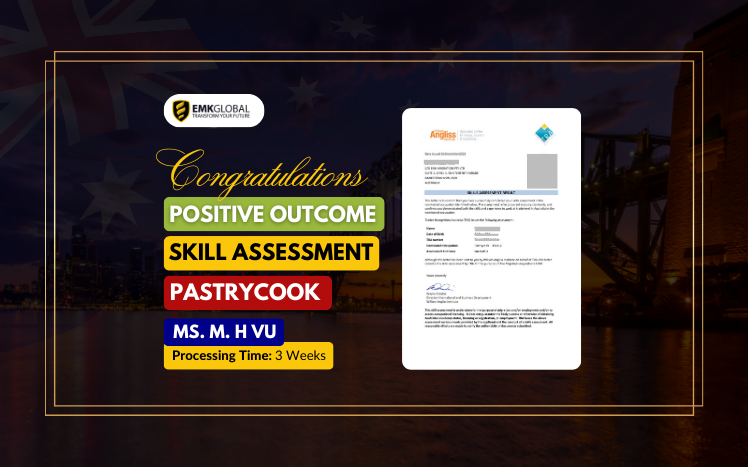

M. H. Vu, congratulations on your visa grant through TRA for your culinary skills! 🎉 The EMK Global team is excited for your new adventure and wishes you continued success in your career as a Pastrycook. 🍰👨🍳

Muhammad B., congratulations on securing your visa grant through the TRA Job Ready Program! 🎉 EMK Global is proud of your accomplishment and we wish you great success in your career as a Motor Mechanic. 🚗🔧
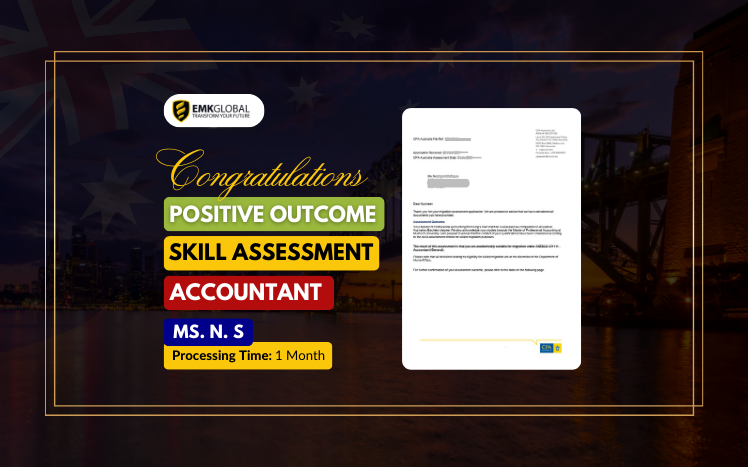
Congratulations, Ms. N. S., on your successful visa grant through the CPA pathway! 🎉 The entire EMK Global team is thrilled for you and wishes you the best of luck in your new journey as an Accountant. 🌟

The Australian Government has introduced new amendments to the Migration Regulations 1994, impacting onshore student visa applications. The latest amendment, Migration (Specification of Categories of Visas that Preclude a Person from Lodging a Student Visa Application in Australia) Amendment Instrument (LIN 24/051) 2024, specifies additional categories of substantive temporary visas that prevent individuals from applying for a Student (Subclass 500) visa or a Student Guardian (Subclass 590) visa while in Australia. These changes take effect from July 1, 2024.
Under Item 1222(5)(c) of Schedule 1, LIN 24/051 amends the earlier IMMI 16/016 by adding six new visa subclasses to the list of those ineligible to apply for onshore student visas. This amendment aims to regulate the visa hopping phenomenon and ensure that the integrity of Australia’s visa system is maintained.
The following six substantive temporary visa subclasses have been added to the list of those ineligible for onshore student visa applications:
The amendments aim to curb the practice of visa hopping, where individuals exploit temporary visas to remain in Australia for extended periods by sequentially applying for different visas. This move is intended to strengthen the integrity of the Australian visa system and ensure that it serves its intended purpose.
The LIN 24/051 amendment introduces significant changes for those planning to apply for student visas while onshore in Australia. By including additional temporary visa subclasses in the list of those precluded from onshore applications, the Australian Government seeks to enhance the regulation of its visa system. Prospective students and guardians must now be more strategic in their visa planning and may need to make applications from outside Australia.
For further information, individuals are encouraged to consult the full text of the LIN 24/051 amendment and seek professional advice if needed.
This new amendment highlights the importance of understanding and adhering to visa regulations when planning to study in Australia. Ensuring compliance will help maintain the integrity of the Australian immigration system and provide a fair process for all applicants.
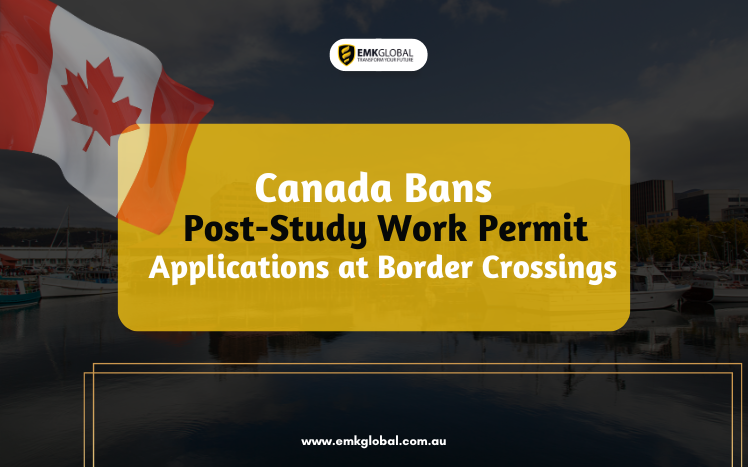
Effective immediately, international students in Canada are no longer permitted to apply for a post-graduation work permit (PGWP) at a Canadian border crossing. This announcement was made by Canadian Immigration Minister Marc Miller on 21 June 2024.
The new regulation aims to close a loophole where students have been bypassing processing times for PGWP applications filed within Canada by accessing same-day immigration services at border crossings. This practice, known as “flagpoling,” has been a common method for students to expedite their work permit applications.
According to a statement from Immigration, Refugees and Citizenship Canada (IRCC), flagpoling consumes significant resources at the border, diverting officers from their primary enforcement duties, causing delays for travelers, and slowing down the movement of goods. From 1 March 2023 to 29 February 2024, PGWP applicants accounted for about one-fifth of the foreign nationals attempting to flagpole.
Minister Miller emphasized that while the contributions of international graduates to Canada’s labor market are valued, flagpoling is unnecessary. He stated, “The time and effort required to process applications from ‘flagpolers’ takes officers on both sides of the border away from their crucial role in protecting the safety, security, and prosperity of Canadians and Americans. This measure will help prevent this practice while maintaining the integrity of our immigration system.”
IRCC highlighted that in most cases, a study permit expires 90 days after the expected completion of an international student’s study program. Eligible students who apply online for a PGWP before their study permit expires can work full-time while waiting for approval on a work permit. They receive an automated letter to show employers, and the work permit is mailed directly to the student upon approval.
In conjunction with the ban on flagpoling for PGWP applicants, IRCC has reduced the availability of same-day immigration services at 12 ports of entry across Canada. This change aims to allow border services officers to efficiently process the large volume of travelers during peak periods and to focus on other key priorities, such as managing high-risk travelers and facilitating trade.
To further support international graduates, IRCC is working to speed up processing times for PGWP applications filed within Canada. The online application process for foreign graduates is being simplified, and PGWP holders are allowed to start working for a new employer immediately, without waiting for a new PGWP application to be processed before making a job change.
The new rule banning PGWP applications at Canadian border crossings is designed to streamline immigration processes, reduce resource strain at borders, and maintain the integrity of Canada’s immigration system. International students are encouraged to apply online for their post-graduation work permits to ensure a smoother transition into the Canadian workforce.
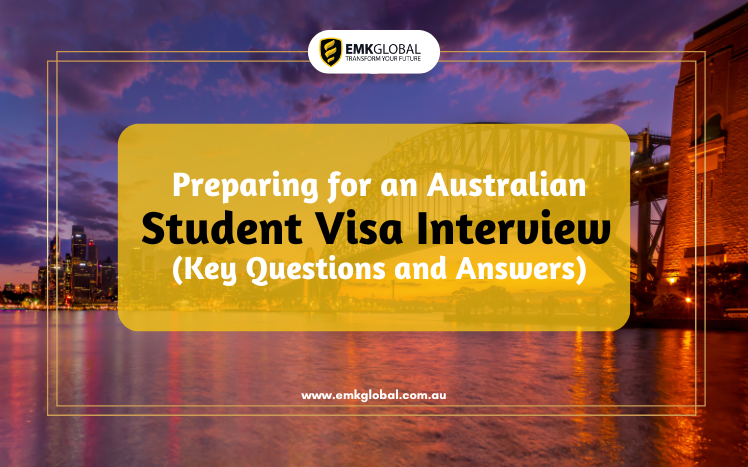
If you intend to pursue your education in Australia, preparing for the student visa interview is crucial. The Australian Government has a rigorous selection process, and being ready for challenging questions can significantly increase your chances of success. In this guide, we outline frequently asked questions and provide advice on how to answer them effectively.
Your answer should be concise and clear, outlining your intention to pursue a specific degree or study program in Australia.
Explain your motivation for selecting Australia over other countries, highlighting factors such as world-class universities, a variety of courses, and promising career prospects after graduation.
Answer truthfully. If you have, mention the reason for your visit and the duration of your stay.
Provide the name of the institution where you have been accepted. Make sure you pronounce the name correctly.
Demonstrate your awareness of your institution’s exact location and its surrounding area’s specialties.
If you chose a college, explain why it was a better fit for your goals, such as offering a specific course you wanted.
Highlight key features of the university and what attracted you to it.
Be honest about any other applications you made and the responses you received.
Explain how the course aligns with your career goals and why it is essential for your future.
Justify your decision to return home after completing your course, demonstrating your commitment to your home country.
Provide an overview of the course and its structure to show your interest and understanding.
State the correct duration, such as one or two years, depending on your course.
Be aware of the commencement and end dates of your course and answer honestly.
State the cost in Australian dollars (AUD) as shown on your Confirmation of Enrolment (CoE).
Answer carefully, emphasizing that your financial support comes from reliable sources and not part-time work.
Explain why studying in Australia is a better option than in your home country.
Be honest about your future plans, whether you intend to continue studying or return home.
State that your intention is to return home after your studies, as the student visa does not provide a direct path to permanent residency.
Answer truthfully about the number of acceptances you received.
Share your plans openly, such as spending time with family in your home country.
Indicate that your primary focus is your studies and that you do not plan to work in Australia.
Provide the name of your previous institution and your academic credentials.
If applicable, explain the reasons for changing your field of study sincerely and clearly.
Provide details about your siblings, their residence, and occupation.
Demonstrate your awareness of the work restrictions, such as the 40 hours per fortnight limit during the semester.
Give a verifiable response, mentioning the person or entity funding your education and stay.
Provide accurate details about your sponsor’s income and occupation, aligning with your supporting documents.
Show that your sponsor can support you financially without any issues.
Answer honestly, providing your original exam transcript and explaining any efforts to improve.
State the benefits of studying in Australia and how your enrollment will contribute to the university.
Express your determination to reapply, highlighting the importance of studying in Australia for your future.
List your possessions, such as vehicles, houses, or businesses, to demonstrate your ties to your home country.
Answer honestly about whether your partner will accompany you to Australia.
Assure the case officer that your sponsor can cover any financial difficulties.
Confirm that you are a responsible tax-paying citizen if applicable.
State your latest educational qualification, whether it’s a high school diploma or a degree.
Explain any gaps in your education honestly, providing valid reasons.
Highlight how the course will help you achieve your career goals upon returning home.
By thoroughly preparing for these questions, you can approach your Australian student visa interview with confidence and clarity.
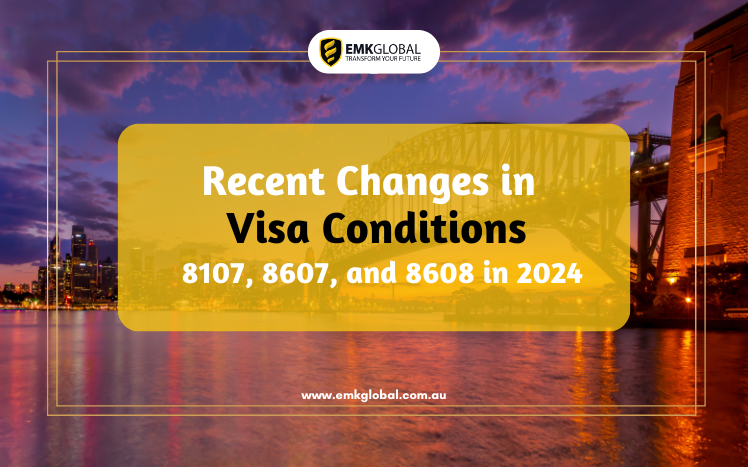
Starting from July 1, 2024, the Australian Government is set to introduce significant changes to visa conditions 8107, 8607, and 8608 as part of the New Migration Strategy. These changes aim to enhance labor productivity, prevent worker exploitation, and support the labor market mobility of temporary migrants. The adjustments will affect holders of Temporary Work (Skilled) visa (subclass 457), Temporary Skill Shortage visa (subclass 482), and Skilled Employer Sponsored Regional (provisional) visa (subclass 494).
If visa holders of subclasses 457, 482, and 494 cease working with their sponsoring employer, they will now have more time to:
Visa holders will be allowed up to:
During the extended time periods, visa holders are permitted to work for other employers, including those in occupations not listed in their most recent approved nomination for sponsorship. This change aims to help workers maintain their standard of living while they search for new sponsors.
Sponsors must notify the Department of Home Affairs within 28 days of any changes, such as when a visa holder resigns or when sponsorship ends. For more detailed information, sponsors can visit the official website: Sponsorship Obligations for Standard Business Sponsors.
The changes in visa conditions 8107, 8607, and 8608 will apply to both existing 457, 482, and 494 visas and those issued on or after July 1, 2024. Any periods during which a visa holder stopped working with their sponsor before July 1, 2024, will not count towards the new time limits.
If you are a visa holder worried about these new changes, it is crucial to seek authentic and updated information regarding your visa conditions and obligations. Contact our team of experts and immigration lawyers at The Migration for customized solutions to your specific concerns.
Visa holders of subclasses 457, 482, and 494 will be provided with:
During this time, visa holders can work for other employers.
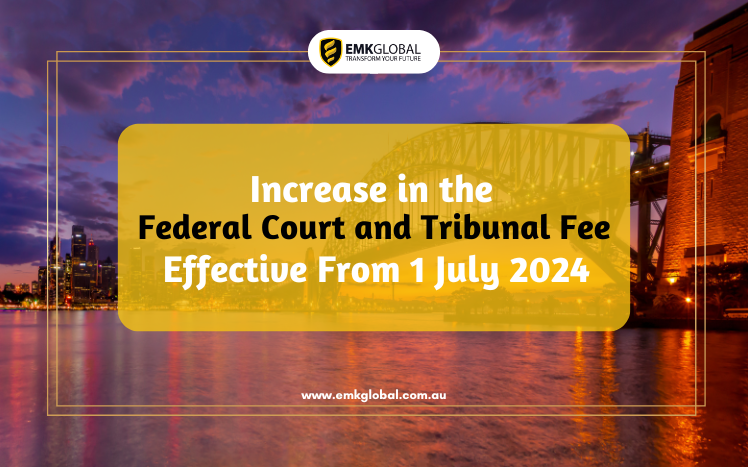
Fee increases for Federal Courts and Tribunals have been officially gazetted and will take effect from 1 July 2024. These adjustments will impact application fees for various reviews and filings, reflecting an upward revision from the previous fee structure. Below is a detailed breakdown of the new fees.
From 1 July 2024, the application fees for reviews by the Administrative Appeals Tribunal will be as follows:
| Type of Review | New Fee | Previous Fee | Reduced Fee (50%) |
| Review of a migration decision under Part 5 of the Migration Act 1958 | $3,496 | $3,374 | $1,748 |
| Review of a protection visa decision under Part 7 of the Migration Act 1958 | $2,151 | $2,076 | N/A |
Note: The fee for a review of a protection visa decision is generally payable only if the application is unsuccessful.
The fees for filing an application with the Federal Circuit Court for a migration decision will also increase from 1 July 2024:
| Type of Application | New Fee | Previous Fee | Reduced Fee |
| Full fee for filing an application | $3,920 | $3,785 | N/A |
| Reduced fee under s 2.06A | $1,960 | $1,890 | N/A |
Members seeking further details on these fee increases are advised to consult the Government gazette. Additional information is available on the Administrative Appeals Tribunal (AAT) website and the Federal Circuit and Family Court of Australia website.
These fee changes emphasize the necessity for applicants and practitioners to stay informed about the evolving costs associated with legal processes in Federal Courts and Tribunals.
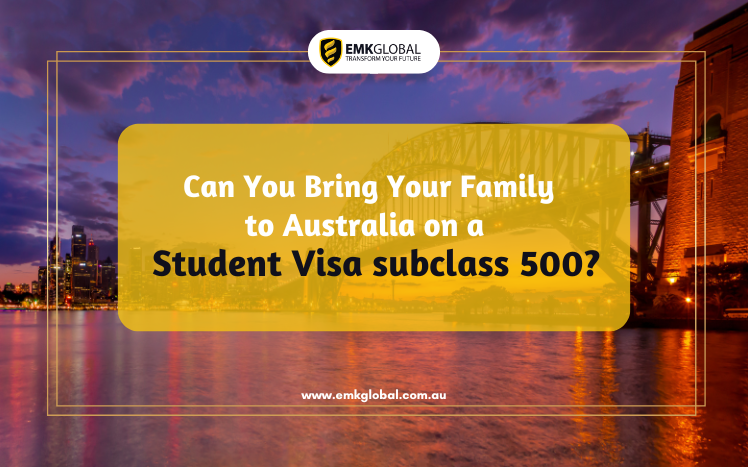
Yes, you can bring your family to Australia on a student visa. You can add your family members and dependents while submitting your application for a student visa in Australia. While submitting your initial application for a student visa, you can include your family in your application, or you can wait until your course starts before inviting them to join you.
Even if you don’t intend to travel to Australia with your immediate family, you should list them on your visa application. Your family members won’t be able to travel to Australia with you later if you don’t declare them in your visa application.
You can add your immediate family members to your student visa application, including:
As an international student, you must fulfill the following eligibility requirements to bring your family members on a student visa:
You can add your spouse or de facto partner to your student visa application as a secondary applicant. For this purpose, you must submit evidence to support your relationship with your partner, including a marriage certificate and evidence of combined accommodation. Moreover, you and your partner must demonstrate that you are genuine temporary entrants.
Remember that your partner may have different work rights than you. In addition, you can also check the visa conditions and work rights by the visa grant letter or using the Visa Entitlement Verification Online system (VEVO).
You can bring your children to Australia if they are under 18 years of age while submitting a visa application. However, if they are 18 or above, they must apply for their own visa. In Australia, the cost of sending any dependent children to a public or private school falls on you. Australia’s school age is around five years old, while each state and territory may have a different start date.
There are child care centers on or close to the campuses of Australian educational institutions. Consider choosing a health care service that aligns with you and your child’s best interests.
You can bring your parents to Australia with you if you are a student under the age of 18 so that they can offer support and care to you during your stay. But they must be:
For this purpose, your parents must apply for a Student Guardian visa. Keep in mind that your parents cannot work in Australia and must live with you during their stay. Moreover, they must be genuine temporary entrants.
Even if your family members do not intend to go to Australia right away, they must be listed on your student visa application. They won’t be able to accompany you to Australia on a student visa at any point if you don’t include them on your application.
Your family member or members may later apply via ImmiAccount as a subsequent entrant, independent of your application. After submitting your application and before your visa application is decided, if someone becomes a member of your family, you need to notify the Department of Home Affairs of the change in your situation.
So by now, you’ve got the answer to your question “Can I bring my family to Australia on a student visa?”. You can add your immediate family members to your application for a student visa or you can also invite them after starting your course in Australia. However, if you have any questions or confusion, it is better to consult an immigration lawyer instead of trying on your own.

EMK Global Education and Migration is offering a unique opportunity for onshore temporary visa holders to apply for a new student visa with a $0 Confirmation of Enrollment (COE) deposit. This special offer aims to make it easier for temporary visa holders to continue their education in Australia without the burden of an initial course fee.
For a limited time, EMK Global Education and Migration is waiving the initial course fee for eligible applicants. This means that onshore temporary visa holders can enroll in a course without making any upfront payments, easing the financial burden and making it more accessible for those looking to further their education in Australia.
In addition to the zero initial course fee, EMK Global offers same-day processing for all offer letters and Confirmation of Enrollments (CoEs). This expedited service ensures that applicants receive their necessary documentation promptly, allowing them to proceed with their student visa applications without delay.
This offer is available exclusively to onshore temporary visa holders. It is designed to provide a smooth transition for those looking to continue their studies in Australia. However, it is important to note that terms and conditions apply. Interested applicants should contact EMK Global Education and Migration to understand the specific requirements and ensure they meet the eligibility criteria.
This special promotion is valid until the end of June 2024. Onshore temporary visa holders are encouraged to take advantage of this offer before it expires. By doing so, they can secure their place in an educational institution without the need for an initial course fee, and benefit from the convenience of same-day processing for their offer letters and CoEs.
EMK Global Education and Migration’s offer of a $0 COE deposit and same-day processing for onshore temporary visa holders presents a valuable opportunity for those looking to continue their education in Australia. With no initial course fee required and expedited documentation, this limited-time offer provides significant financial relief and convenience. Eligible individuals are encouraged to act quickly and contact EMK Global to take advantage of this promotion before the end of June 2024.
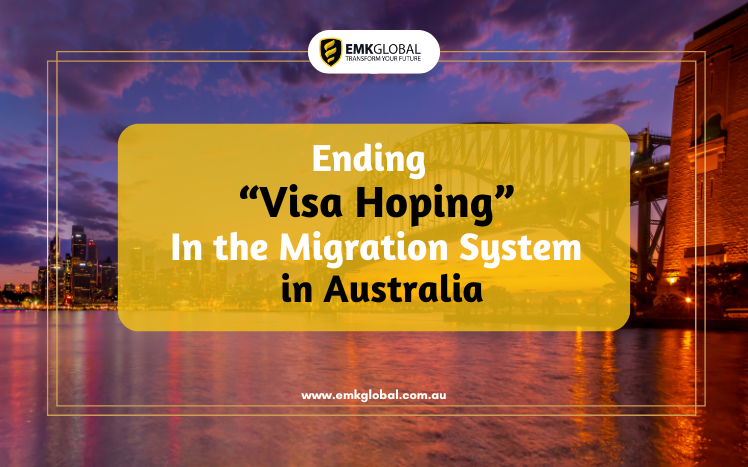
In a significant policy shift, the Australian government has announced new measures to close two temporary visa pathways. Effective from 1 July 2024, Visitor Visa holders and Temporary Graduate Visa holders will no longer be able to apply for Student Visas from within Australia. This move is part of a broader package of migration reforms aimed at tightening visa regulations and maintaining the integrity of Australia’s immigration system.
From 1 July 2024, individuals holding Visitor Visas will be prohibited from transitioning to Student Visas while in Australia. This decision follows a notable increase in such applications, with over 36,000 submitted from 1 July 2023 to the end of May 2024. The Department of Home Affairs highlighted that this pathway had become a prevalent method for individuals to bypass standard immigration procedures.
Similarly, Temporary Graduate Visa holders will no longer be eligible to apply for Student Visas onshore starting 1 July 2024. This measure addresses concerns raised in an October 2023 report by the Grattan Institute, which found that many Temporary Graduate Visa holders pursued further study to extend their stay. The report revealed that less than one-third of these visa holders transition to permanent residency upon visa expiry, compared to two-thirds in 2014. Instead, many opt for cheaper vocational courses to prolong their stay, creating a “visa limbo.”
The Australian government aims to direct graduates towards securing skilled jobs and either transitioning to permanent residency or leaving the country. This is part of a larger strategy to reduce net overseas migration and ensure a more planned and strategic approach to migration. Minister for Home Affairs Clare O’Neil stated, “Our goal is to build a smaller, better planned, more strategic migration system that works for Australia. Our Migration Strategy outlines a clear plan to close the loopholes in international education and this is the next step in delivering that plan.”
The new measures will significantly impact international students and graduates currently in Australia or planning to study there. Educational institutions and businesses reliant on international talent may need to adjust their strategies to comply with the new regulations. While some stakeholders in the education sector express concerns about potential decreases in international student enrollment, proponents argue that the reforms will help maintain the integrity of Australia’s migration system and ensure that those who stay contribute meaningfully to the economy.
As Australia continues to refine its migration policies, these changes mark a pivotal shift towards a more controlled and strategic approach to managing international education and migration. The closure of these visa pathways is a critical step in the government’s effort to build a more sustainable and integrity-focused migration system.
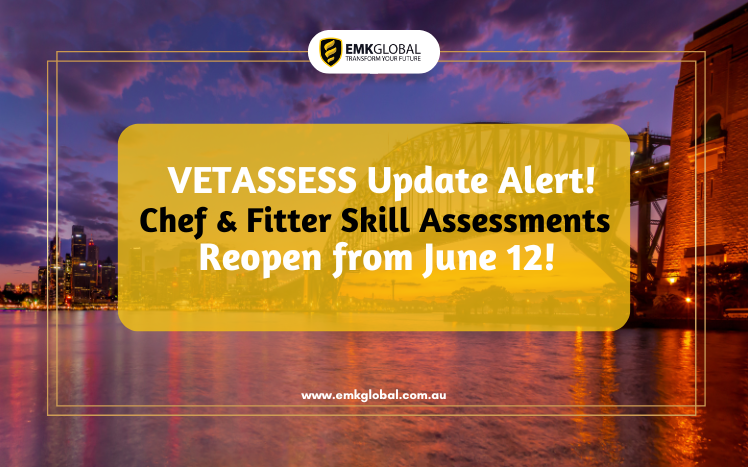
Great news for aspiring migrants aiming to build their careers in Australia! Starting June 12, VETASSESS will reopen applications for skill assessments in the occupations of Chef and Fitter. This is a significant update following the pause on new applications for these roles since September 2023.
VETASSESS, a prominent skills assessment authority, had temporarily halted new applications for Chefs and Fitters to ensure their processes remained efficient and up-to-date. This pause allowed them to refine their assessment methods and ensure that they meet the highest standards required for Australian migration.
The reopening of these skill assessments means that aspiring Chefs and Fitters can now start their application process. This is a crucial step for those looking to migrate to Australia, as a positive skill assessment is often a prerequisite for visa applications.
High Demand Occupations: Australia has a growing demand for skilled professionals in the culinary and mechanical trades. Chefs and Fitters are highly sought after in various sectors, from hospitality to manufacturing, making these professions attractive for potential migrants.
Career Opportunities: Migrating as a Chef or Fitter opens doors to numerous career opportunities across Australia’s vibrant cities and regions. These roles not only offer competitive salaries but also provide a pathway to long-term residency and career advancement in a supportive and dynamic environment.
Navigating the migration process can be complex, but you don’t have to do it alone. EMK Global Education and Migration offers comprehensive support to ensure your skill assessment and migration journey is smooth and successful.
If you’re dreaming of a new life in Australia as a Chef or Fitter, now is the time to act. With the reopening of skill assessments, your pathway to migration is clearer than ever.
Contact EMK Global Education and Migration today to start your skill assessment process. Our dedicated team is here to help you achieve your migration goals and embark on a successful career in Australia.
Don’t miss this opportunity to take the next step towards your Australian dream!